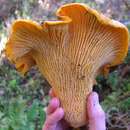pt-BR
nomes no trilho de navegação


Cantharellus californicus, sometimes called the mud puppy or oak chanterelle, is a fungus native to California, United States.[2] It is a member of the genus Cantharellus along with other popular edible chanterelles. It is generally similar in appearance to C. cibarius and C. formosus except for its large size at maturity; individual specimens larger than 1 kilogram (2.2 lb), or greater (2 kilograms (4.4 lb)), are reported, making it the largest known species of chanterelle.[1] Their unusual size is due in part to their capacity for indeterminate growth, making Cantharellus californicus specimens actively grow for far longer than most other mushrooms.[3]
The pileus (cap) of C. californicus is 5–30 centimetres (2–12 in) wide,[4] or greater (50 cm (20 in)), and yellow-orange in color although adhering leaf litter may cause a mottled color; may become brownish with age. The hymenium is folded into decurrent ridges (false gills) and cross-veins, which deepen with age. The color of these ridges is usually similar to the pileus but paler. The stipe (stem) is 2–10 cm (0.8–4 in) long and 1–4 cm (0.39–1.57 in) wide,[4] with coloration similar to the hymenium.[1] The spores are creamy yellow, elliptical, and smooth.[4]
Cantharellus californicus forms a mycorrhizal association with oaks, particularly coast live oak in the woodlands of Coastal California. It has also been found in association with interior live oak, California black oak, canyon live oak, tanoak, and possibly Pacific madrone and manzanita.[1] C. californicus is a popular wild edible in the San Francisco Bay Area, and is most common between November and April.[1][5]
Several other species of chanterelle may be found in western North America:
Additionally, Hygrophoropsis aurantiaca, Chroogomphus tomentosus, and species in the genera Craterellus, Gomphus, Omphalotus, and Polyozellus may have a somewhat similar appearance to C. californicus. Omphalotus olivascens, the western jack-o'-lantern mushroom, is poisonous and has been mistaken for chanterelles.
Cantharellus californicus, sometimes called the mud puppy or oak chanterelle, is a fungus native to California, United States. It is a member of the genus Cantharellus along with other popular edible chanterelles. It is generally similar in appearance to C. cibarius and C. formosus except for its large size at maturity; individual specimens larger than 1 kilogram (2.2 lb), or greater (2 kilograms (4.4 lb)), are reported, making it the largest known species of chanterelle. Their unusual size is due in part to their capacity for indeterminate growth, making Cantharellus californicus specimens actively grow for far longer than most other mushrooms.
Cantharellus californicus es una especie de hongo comestible, nativo de California, Estados Unidos, miembro del género Cantharellus, de la familia Cantharellaceae.[1][2]
El sombrero es convexo, irregular, enrollado u ondulado. Su color es amarillento y puede medir hasta 30 centímetros. El pie es de color blanquecino a amarillento, y puede medir hasta 10 centímetros y tener un grosor de 4 centímetros.
Es un hongo de gran tamaño, se han encontrado ejemplares que han pesado 1 kilogramo. Forma una asociación micorrícica con el roble. Aparecen a finales del otoño y a principios del invierno después de las lluvias.
Es un hongo comestible, de sabor suave y aroma dulzón.
Cantharellus californicus es una especie de hongo comestible, nativo de California, Estados Unidos, miembro del género Cantharellus, de la familia Cantharellaceae.
Cantharellus californicus est une espèce de champignons basidiomycètes du genre Cantharellus dans la famille des Cantharellaceae décrite en 2008 par David Arora et Susie M. Dunham (université de l'Oregon) dans un numéro spécial champignons de la revue Economic Botany[2].
En Californie (États-Unis), les cuisiniers parlent d'elle comme de la chanterelle du chêne, les récoltants la qualifient de chanterelle de la boue, tandis qu'en France on l'appelle communément girolle.
Un mycologue américain, David Arora, a observé ces champignons jaune orangé de plus près. Après des études morphologiques et moléculaires, il en ressort que le champignon californien que l'on prenait pour Cantharellus cibarius, la vraie girolle baptisée scientifiquement en France en 1821, est bien une espèce différente, qu'il nomme Cantharellus californicus.
Dans le monde, le marché des chanterelles pèserait 1,3 milliard d'euros pour les producteurs, souligne David Arora. Pour clarifier le marché, il devenait important de distinguer les différentes formes de chanterelles, qui n'ont pas toutes les mêmes qualités gustatives. D'autant que les récoltants ont tout à gagner à en savoir plus sur leur productivité et leur physiologie.
Plus gros - il n'est pas rare de trouver des Cantharellus californicus de 1 kg - plus fibreux et moins parfumé, ce nouveau champignon n'est pas le plus apprécié des chefs. Pourtant son prix atteint régulièrement des sommets (de 7 à 17 euros par kg pour le récoltant), notamment parce qu'il pousse entre novembre et avril, une période durant laquelle les autres espèces de Cantharellus sont rares.
En moyenne, on estime qu'environ 23 tonnes de Cantharellus californicus sont ramassées chaque année en Californie. Cantharellus californicus pousse en forêt de chênes, mais préfère les espèces de chênes vivant sur la côte californienne à celles de l'intérieur des terres[3].
Cantharellus californicus est une espèce de champignons basidiomycètes du genre Cantharellus dans la famille des Cantharellaceae décrite en 2008 par David Arora et Susie M. Dunham (université de l'Oregon) dans un numéro spécial champignons de la revue Economic Botany.
En Californie (États-Unis), les cuisiniers parlent d'elle comme de la chanterelle du chêne, les récoltants la qualifient de chanterelle de la boue, tandis qu'en France on l'appelle communément girolle.